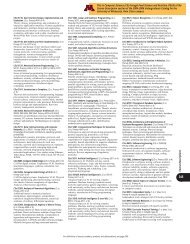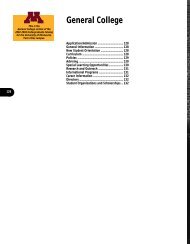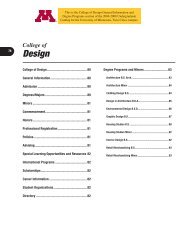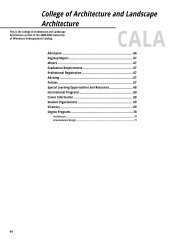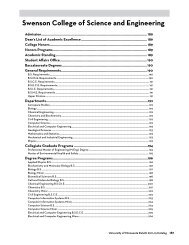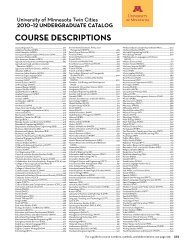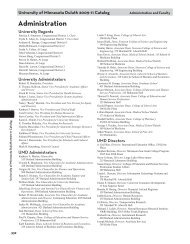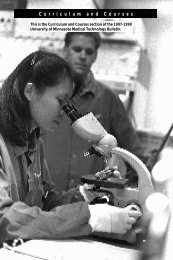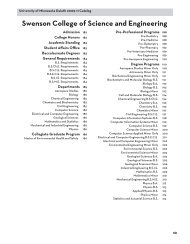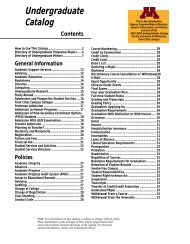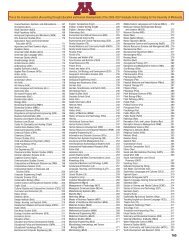CoursesâA through G and course numbers and symbols key
CoursesâA through G and course numbers and symbols key
CoursesâA through G and course numbers and symbols key
- No tags were found...
You also want an ePaper? Increase the reach of your titles
YUMPU automatically turns print PDFs into web optimized ePapers that Google loves.
ApEc 5152. Applied Macroeconomics: Income <strong>and</strong>Employment. (2 cr. Prereq–Econ 5152 or #)Static general equilibrium open economy models <strong>and</strong>simple business cycle models examine economicgrowth, business cycles, <strong>and</strong> fiscal <strong>and</strong> monetarypolicy. Input-output analysis <strong>and</strong> large scaleeconometric models. Sources <strong>and</strong> properties ofeconomy <strong>and</strong> sector-wide data, <strong>and</strong> empiricalapplications.ApEc 5321. Regional Economic Analysis. (3 cr.Prereq–3006 or Econ 3102 or #)Regional development patterns <strong>and</strong> role of resources,transportation, <strong>and</strong> institutional constraints. Trade,migration, <strong>and</strong> investments in regional growth <strong>and</strong>change. Regional economic information ininvestment <strong>and</strong> location decisions. Evaluation ofeconomic development policies <strong>and</strong> tools. Economicimpact analysis.ApEc 5341. State <strong>and</strong> Local Public Services <strong>and</strong>Finance. (3 cr; A-F only. Prereq–3001 or equiv)The organization, delivery, economic analysis <strong>and</strong>finance of state <strong>and</strong> local public services <strong>and</strong>functions.ApEc 5401. Price Analysis, Futures, <strong>and</strong> OptionsMarkets. (3 cr. Prereq–[3002 with grade of at least B,[Math 1142 or equiv]] or grad student)Development/application of price models. Uniquemarket institutions in agriculture that have beendeveloped in response to marketing/pricingproblems. Futures/options trading. Hedging,speculative uses of futures/options contracts. Priceefficiency, market performance/regulations.ApEc 5511. Labor Economics. (3 cr. Prereq–[[3001 orEcon 3101 or PA 5021], [PA 5032 or equiv], gradstudent] or #)Theoretical foundations of labor markets.Intertemporal/household labor supply. Dem<strong>and</strong> forlabor, efficiency wages. Human capital theory,unemployment, migration decisions. Analysis ofeconometric research applied to labor policy issuessuch as minimum wage, tax policy, social insurance,education.ApEc 5551. Food Marketing Economics. (3 cr; A-Fonly. §4451, §FScN 4451. Prereq–3001 or Econ 3101)Economics of food marketing in the United States.Food consumption trends. Consumer food behavior,expenditure, data collection. Consumer utilitymodels, dem<strong>and</strong> forecasting. Food distributionsystem. Changes in supply chain, industry structurethat serves retail food outlets. Individual/groupprojects.ApEc 5581. Human Capital <strong>and</strong> HouseholdEconomics. (3 cr. Prereq–3001 or Econ 3101 or #)Household economics <strong>and</strong> investment in humancapital (e.g., children, education, health <strong>and</strong>nutrition); labor force participation, lifetimeearnings, <strong>and</strong> nonmarket work; time allocation <strong>and</strong>substitution of capital for labor in the household inthe western <strong>and</strong> third world.ApEc 5611. L<strong>and</strong> <strong>and</strong> Water Economics. (3 cr.Prereq–3001 or Econ 3101 or #)L<strong>and</strong> as an economic <strong>and</strong> cultural resource. Propertyrights concepts, valuation of resources, <strong>and</strong> policyanalysis. Materials drawn from economics, forestry,public finance, planning, <strong>and</strong> agriculture.ApEc 5637. Agricultural Law. (3 cr. Prereq–Sr or grador #)Economic regulation of agriculture. Industrialorganization <strong>and</strong> market structure in agribusiness,public l<strong>and</strong>s <strong>and</strong> water law, agricultural cooperatives,farm labor, farm finance, crop insurance <strong>and</strong> disasterassistance, agricultural biotechnology, food <strong>and</strong> druglaw, price <strong>and</strong> income regulations, <strong>and</strong> internationalagricultural marketing.ApEc 5651. Economics of Natural Resource <strong>and</strong>Environmental Policy. (3 cr. Prereq–[3001 or Econ3101], [4611 or Econ 3611 or NRES 3261W], 60 cr)Economic analyses, including project evaluation ofcurrent natural resource/environmental issues.Emphasizes intertemporal use of natural resources,natural resource scarcity/adequacy, environmentalquality, <strong>and</strong> mechanisms for pollution control <strong>and</strong>their implications for public policy.ApEc 5711. U.S. Agricultural <strong>and</strong> EnvironmentalPolicy. (3 cr. Prereq–3001 or Econ 3101)U.S. agricultural policy in an open world economy;role of private markets <strong>and</strong> government in regulatingsupply <strong>and</strong> dem<strong>and</strong>; income vs. price support, supplycontrols, environmental constraints, <strong>and</strong> exportprotectionism; functioning of markets; roles ofpublic interest groups <strong>and</strong> future of Americanagricultural policy.ApEc 5721. Economics of Science <strong>and</strong> TechnologyPolicy. (3 cr. Prereq–[[5151 or 5151], PA 5022] or #)Economics of technical change, research, <strong>and</strong>technology. Productivity. Methods for evaluatingimpacts of R&D. Intellectual property rights.ApEc 5731. Economic Growth <strong>and</strong> InternationalDevelopment. (3 cr. Prereq–3002 or [Econ 3101, Stat3022]; Econ 4211 recommended)Economics of research/development. Technicalchange, productivity growth. Impact of technologyon institutions. Science/technology policy.ApEc 5751. Agricultural Trade <strong>and</strong> Trade Policy:Issues <strong>and</strong> Analysis. (3 cr. Prereq–3001 or Econ 3101 orPA 5021)Trade policies of import/export nations, gains fromtrade, trade negotiations/agreements. Free trade <strong>and</strong>common market areas. Exchange rate impacts.Primary commodities <strong>and</strong> market instability. Currenttrade issues.ApEc 5811. Cooperative Organization. (3 cr.Prereq–3001, 3002 or #)Application of economic analysis to the cooperativeform of organization. Producer <strong>and</strong> consumercooperatives used to examine economic issues suchas changing market organization, financing,management incentives, taxation, <strong>and</strong> antitrustregulations. Cooperatives as a tool for economicdevelopment included.ApEc 5861. Economics of Agricultural Production.(3 cr. Prereq–5151 or Econ 5151 or #)Production economics applied to agriculture,profitable combination of production factors;comparative advantage <strong>and</strong> location of production.ApEc 5891. Independent Study: Advanced Topics inFarm <strong>and</strong> Agribusiness Management. (1-4 cr.Prereq–#)Special topics or individual work suited to the needsof particular groups of students.ApEc 5991. Special Topics <strong>and</strong> Independent Studyin Applied Economics. (1-4 cr [max 12 cr]. Prereq–#)Special classes, independent study, <strong>and</strong> supervisedreading <strong>and</strong> research on subjects <strong>and</strong> problems notcovered in regularly offered <strong>course</strong>s.Arabic (Arab)Department of African American <strong>and</strong> AfricanStudiesCollege of Liberal ArtsArab 1101. Beginning Arabic. (5 cr)Oral practice, reading, comprehension, basicgrammar. For students with no previous training inArabic.Arab 1102. Beginning Arabic. (5 cr. Prereq–1101 orequiv or #)Comprehension, oral practice, <strong>and</strong> reading ofst<strong>and</strong>ard Arabic. Continuation of 1101.Arab 1201. Colloquial Arabic. (5 cr)Fundamentals of vocabulary <strong>and</strong> sentence structure.Introduction to Arabic script. Primarily for businesspersons <strong>and</strong> travelers.Arab 1202. Colloquial Arabic. (5 cr. Prereq–1201 or #)Fundamentals of vocabulary <strong>and</strong> sentence structure.Introduction to Arabic script. Primarily for businesspersons <strong>and</strong> travelers.For definitions of <strong>course</strong> <strong>numbers</strong>, <strong>symbols</strong>, <strong>and</strong> abbreviations, see page 296.Course DescriptionsArab 3036. Islam: Religion <strong>and</strong> Culture. (3 cr. §Afro5036)Religion of Islam, faith, practices, sectariansplintering, expansion outside original home to statusof world religion, institutions, status in worldsocieties—Asia, Europe, the Americas.Arab 3101. Intermediate Arabic I. (5 cr. Prereq–1102or equiv or #)Advanced grammar <strong>and</strong> conversational practice.Reading Arabic texts.Arab 3102. Intermediate Arabic II. (5 cr. Prereq–3101or #)Advanced grammar, analyses of readings, oralcomprehension.Arab 3491. Classical Islamic Civilization. (3 cr. §Afro5491)Islamic legacy in the classical age (800-1400),including medical <strong>and</strong> natural sciences, mathematics,philosophy, literature, <strong>and</strong> their transmission toEurope.Arab 3505. Survey of the Middle East. (3 cr. §5505)Peoples, l<strong>and</strong>s, <strong>and</strong> cultures of the Middle East.Historical survey from earliest civilizations to thepresent.Arab 3514. African-Arabic Literature in Translation.(3 cr)Literature from continental Africa in Arabic. Novels,short stories, poetry, <strong>and</strong> drama by such writers asAbd-al-Hayy, Abd-al-Sabur, Mahfouz, El-Saadawi,<strong>and</strong> Wattar. No knowledge of Arabic required.Arab 3524. Introduction to the Qur’an. (3 cr)Textual, thematic, interpretive, <strong>and</strong> narrative aspectsof the Qur’an <strong>and</strong> its influence on modern Arabicliterature. All readings in English.Arab 3541. Islam in the Catholic Age: Arab Phase600 A.D. to 900 A.D. (3 cr. §5541)The rise of Islam in its Arabian setting. Roles of theprophet, the Orthodox <strong>and</strong> Umayyad Caliphs.Development of the Islamic state <strong>and</strong> empire. Statusof Muslims <strong>and</strong> non-Muslims.Arab 3542. Medieval Islam. (3 cr. §5542)Islamic dynasties, Mamluks <strong>and</strong> Mongols, <strong>and</strong>Crusaders <strong>and</strong> Assassins. Abbasid Caliphate’sdisintegration <strong>and</strong> rise of Seljuk Turks.Arab 3543. Arabs Under Mamluks <strong>and</strong> Ottomans:1300-1920. (3 cr.§5543)Struggle against Crusaders <strong>and</strong> Mongols.Disintegration <strong>and</strong> reemergence under MuhammadAli of Egypt; dynastic struggles in Syria; rise ofYoung Turks; Arab revolt.Arab 3544. Arab World: 1920 to the Present. (3 cr)Struggle in the Arab world for independence <strong>and</strong> its<strong>course</strong> since independence. Emphasis ondevelopment, political stability <strong>and</strong> unity; politicalstructures; the Arab-Israeli conflict.Arab 3547. The Ottoman Empire. (3 cr)Founding of Ottoman society <strong>and</strong> state to empire,1300 to end of the empire in 1920. L<strong>and</strong>s,institutions, peoples, legacy, impact on Europe.Arab 3900. Topics In Arabic Literature, Art, <strong>and</strong>Culture. (3 cr [max 6 cr])Topics vary. Readings are in English.Arab 3993. Directed Study. (1-3 cr. Prereq–#)For advanced students with individual facultymembers.Arab 5001. Research Methods in Arabic Studies.(3 cr)Skills <strong>and</strong> techniques required to deal with medieval<strong>and</strong> modern works in Arabic literature <strong>and</strong> Islam. Asurvey of the most important research bibliographiesin Arabic <strong>and</strong> Islamic studies. Bibliographicreferences in English <strong>and</strong>, when appropriate, Arabic.Arab 5011. Islam in Africa. (3 cr)Ideological, doctrinal, <strong>and</strong> ritual aspects ofcontinental African Islam. Emphasis on variousreligious brotherhoods <strong>and</strong> Sufi orders from differentAfrican countries in the 20th century. No knowledgeof Arabic required.Course Descriptions311



